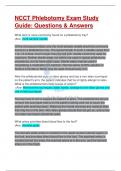Exam (elaborations)
NCCT Study Guide)NCCT Phlebotomy Exam Study Guide: Questions & Answers: Guaranteed APlus Guide
- Course
- Institution
What item is more commonly found on a phlebotomy tray? (Ans- multi-sample needle Of the choices provided, only the multi-sample needle would be commonly found on a phlebotomy tray. The typical length of such a needle varies from 1 to 1.5 inches, much longer than the 5/8 inch needle commonly us...
[Show more]



